|
February
9
We were up at five again, but I
didn’t mind the early wakeup call. Normally at home I hate
getting up that early, but when I am in Africa I can hardly wait
to see what each new day will bring.
The land cruiser would not start
this morning; the guys had to pull it with the other truck to get
it running. After that Gee was careful not to turn it off too
often. I sat in the first row this morning; I liked the view out
the front.
We headed out along the riverbed
and then turned across the bushveld toward the rising sun. The
familiar crowns of Twin Hills and Leopard Rock rose up out of the
flat plain.
Gee examined the assortment of tracks in the sand road;
there was spoor (tracks) from wild dogs, a wildcat, caterpillar
and mouse. A bit further on we saw more tracks; springhare this
time, and also beetle. Gee spotted some fresh leopard tracks; we
scanned the plain to try to find their maker, but we had been
warned it would be hard to find leopards at this time of year
because of the tall grass.
We saw a herd of impala running. At first we looked for
wild dogs but then we realized they were not being chased; all of
the youngsters were running flat out among the trees, circling the
herd, dashing back and forth. They were leaping high and kicking
their heels in the air like they do to escape predators, but in
this case they were doing it for the sheer joy of motion and
speed.
A couple of giraffes strolled by; one stopped and spent
several minutes scratching his neck blissfully against a tall tree
stump. We had a glimpse of another honey badger in the underbrush.
A family of over a dozen dwarf mongooses scurried back and forth
on a fallen tree; they were small, quick and playful, with dark
brown coats and red eyes.
A Secretary Bird strode across the veld. These tall slender
birds of prey can fly perfectly well, but they are more often seen
walking. Black and white with a scraggily fringe of long quills on
the back of their head and neck, they remind me of a tall leggy
chicken, or perhaps the Road Runner from the cartoons. Beep-beep!
|
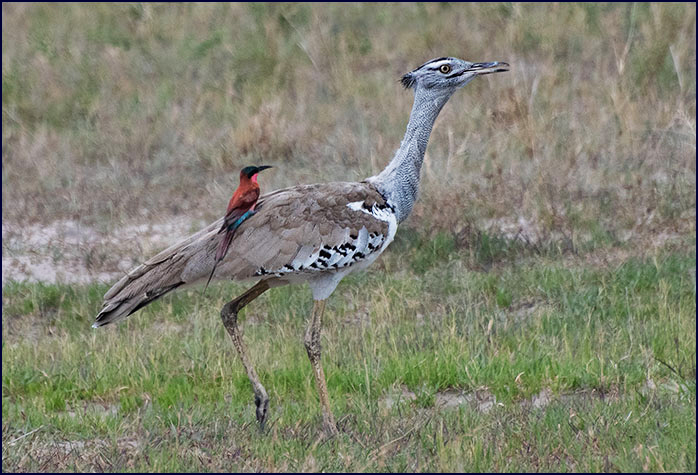
Kori Bustard with Carmine Bee-eater |
As we drove across the Savuti Marsh the carmine bee-eaters
were going crazy beside the vehicle again; it was amazing to
watch them swoop and dive. To our surprise we saw one of the
bee-eaters riding on a kori bustard’s back. Gee said they do
that often, catching a ride scouting for the insects that fly up
at the bustard’s approach. These beautiful birds are quite
opportunistic; a bit further on we saw a pair of them catching a
lift on a warthog.
|
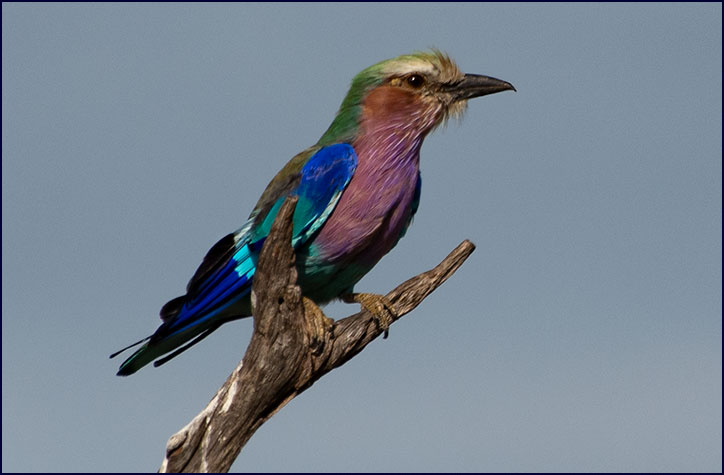
Lilac-breasted Roller
|
We stopped by Rhino Pan; nobody was there this
morning but a few water birds. A lilac-breasted roller posed for
us on a twig; the challenge is to catch a photo of one in flight,
showing the iridescent blue on its wings. We waited long minutes
for him to fly, our arms aching from holding our cameras at the
ready – but when he finally took off he was too quick and I
missed the shot.
|
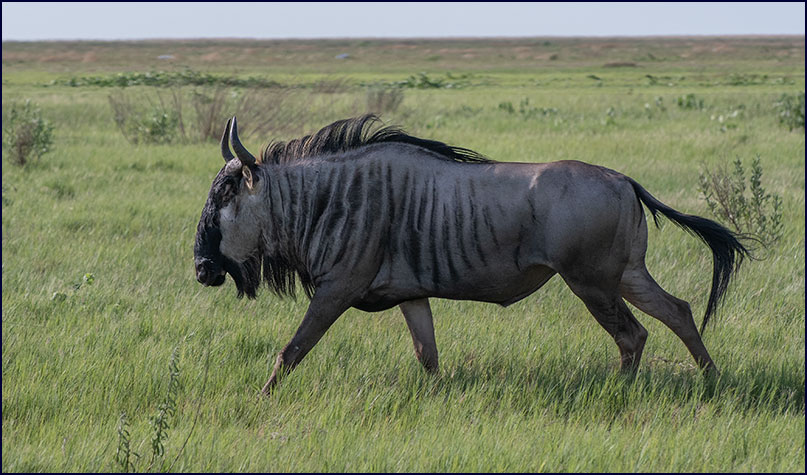
Wildebeest
|
Gee was still searching for the leopard who had made the
tracks we saw earlier, but there was no sign of him. A lone
wildebeest went galloping across the plain in front of us, putting
on a show. He did not seem alarmed - he appeared to be running
just for the fun of it.
A kori bustard strolled by with a baby behind her, walking
right underneath her tail. A bee-eater rode regally on her back.
We watched this unlikely trio make their way slowly across the
plain. Gee said the bustards lay a single egg, raising just one
baby at a time.
|
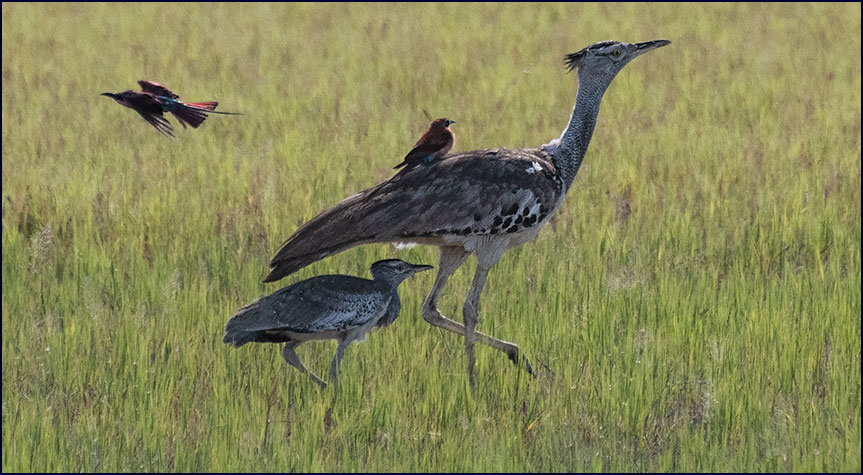
Kori Bustards and friends
|
It was a warm sunny day with just a few patchy clouds
accenting the clear blue sky. We had tea in the shade of a lone
tree. A lizard climbed in the tree; I think it was a skink, and
there was also a long black millipede. After tea the land cruiser
would barely start, so after that Gee kept it running all the
time, even when we were watching wildlife.
A herd of zebras grazed out on the plain, and there were
several babies among them, along with the odd wildebeest. So far
our zebra sightings had been a bit fleeting, and this was the
closest we had gotten to them. I can’t resist zebras; my love of
horses carries over to these rolly-poly striped equids. I hoped to
see a lot more of them.
The zebras’ stripe patterns are as distinctive as
fingerprints - no two are the same. Many of them had faint
‘shadow’ stripes superimposed on the white stripes on their
hindquarters. The herd turned their tails to us and moved away;
anyone who has taken photographs on safari knows about zebra butt
shots.
As we left the open plain and headed into the trees, we
came upon a half dozen tsessebes. The mud-caked adults had several
babies with them. One mother had a tiny caramel-colored calf by
her side, not more than a week old. He had the most marvelous
floppy ears.
|

Tsessebes
|
We stopped to check out the waterhole; four big elephant
bulls were standing by the pan. They sprayed some water around and
then put their heads together to have a drink. For a long while
they stood quietly in companionable silence, just seeming to enjoy
the company. Two of them stood face to face and interlocked their
tusks, pressing against each other affectionately as they brought
their trunks up to their mouths to drink. After a while a pregnant
female came by; her mammary glands, between their front legs, were
noticeably distended.
While we were watching the elephants, a warthog mother with
one baby ambled by. Gee said warthogs nearly always have litters
of four babies, so something must have eaten the other three. Four
Yellow-billed Oxpeckers sat on the mother’s back, and they
seemed to be irritating her. She rubbed up against a small termite
mound to scratch herself, turning this way and that for the best
positioning, but try as she might she could not rid herself of the
oxpeckers. Her baby stayed at her flank the whole time; after what
happened to his three siblings he was not going to stray far from
mom.
|

Warthogs and Red-billed Oxpeckers |
Hundreds of blacksmith lapwings (formerly known as
blacksmith plover) lined the edge of the water behind the
warthogs; I had never seen so many in one place. These handsome
pied birds are said to be named for their call which sounds like a
blacksmith’s hammer hitting an anvil, but I have never heard
them make such a sound.
|

Blacksmith Lapwing
|
Around noon we found more giraffes. A pair of them crossed
the road in front of us; one very light colored female with a
split ear, and a very dark male with one prong bent over at an
angle. Shortly after that we came out to the edge of the plain
where four more giraffes stood, with a long low ridge in
the background. It was
a beautiful scene; fluffy grey and white clouds dotted the blue
sky, and the veld was bathed in golden light. The crest we could
see was the Magwikhwe Sand Ridge; it is 65 feet high and over 150
miles long, and was once part of the shoreline of a huge ancient
lake that covered much of northern Botswana.
In the morning when the land cruiser wouldn't start, Gee
had called Letaka Safaris for help. A mechanic had driven four
hours to get there, and he arrived just as we were finishing our
morning game drive - we met up with him to guide him to camp. He
had brought another game drive vehicle in case he could not fix
ours.
BD was waiting as usual with our
fruit tea when we got back to camp for lunch. Gee turned off the
vehicle and then tried to start it again; it would not start at
all. Good thing we had the mechanic.
The mechanic replaced the battery and worked on the starter
while we had lunch. By 2:30 he had the land cruiser good to go.
Duma, Merle and Solo sat in the console as we set off for the
afternoon drive, and Samba the Mamba was coiled around a
rail.
It
was nap time at the Wildebeest Day Care. We could see two adult
wildebeests with about ten babies, and they were all laying down
close together taking a nap. It was a tender scene. They raised
their heads and stared at us curiously when we came close.
Stopping by a pan, we saw plenty of familiar birdlife. A
flock of Pratincoles flew overhead, wheeling back and forth
against the cloudy sky. A comb duck paddled around with
that ridiculous disc on his bill; I can’t imagine the
evolutionary purpose of it, but it is sure to attract the ladies.
A lilac-breasted roller sat on a
twig while we waited with cameras poised. He seemed to sit there
forever, but this time I finally got a shot of him as he took off.
A group of Abdim’s storks took flight,
circling around over the waterhole before coming in for a somewhat
awkward landing in a dead tree.
|

Abdim’s storks |
We were quite familiar with Leopard Rock from previous
visits; now we learned the names of the other hills that rise up
out of the flat plain near Savuti Channel. Closest to camp is Kudu
Hill, and the next one is Sable Hill. There is another bare ridge
called Quarry Hill. We passed the huge ancient baobab tree known
as the Bushman's Baobab; this magnificent tree is over 1200 years
old and the trunk is twenty feet across. I like to imagine the
things this tree must have seen. The ridge standing nearby is
called Bushman’s Rock.
We stopped to spend a bit of time
with some gorgeous giraffes. Resplendent in the afternoon light,
they stood on the open veld, with the Sand Ridge rising beyond
them.
Gee told us he was going to take us to an area we had never
visited before. We drove a long way through a wooded area without
seeing any wildlife. Eventually we came around a corner and
surprised an elephant with a half grown baby. (Upon reviewing my
photos at home, I was surprised to see that only 12 minutes had
passed between the giraffes and these elephants. This was one of
the longer stretches of time with no wildlife viewing on the
trip.)
We came to the ‘Garden of Baobabs.’ This small rocky
knoll was home to a grove of thirteen age-old baobab trees. We
walked among the mighty trees in awe, climbing over the rocks and
wandering between the huge boles. We were in another world. It
seemed like a magical place, mysterious, perhaps even sacred. We
were quiet, like you would be in church. The bigger trees were
around 300 years old; they were mighty enough to be impressive,
though they did not rival the age and girth of the Bushman’s
Baobab. Still, I imagine they have seen a bit in their lifetimes
– I like to think of them watching the circle of life through
the ages.
|

Tara in the Garden of Baobabs
|
The rocks among the trees help
protect the baobabs from the elephants, but nonetheless many of
the larger trees showed damage on their trunks. There are fewer
baobabs around because the elephants tend to destroy the smaller
ones, which made me appreciate this beautiful grove even more. I
collected a rock for a cairn I built in my yard at home, made with
stones collected from places that have meaning for me. As we were
leaving, we looked back at the grove and bid farewell to the
ageless silhouettes of the baobab trees.
A yellow mongoose was lying in the road in a small spot of
shade. She looked like she was hot. She got up and stretched, then
looked at us and flopped back down in the road again. Reclining on
her back with her feet in the air, she looked like roadkill.
Our new birds for the evening were
a Marico Flycatcher and a beautiful blue Cape Glossy Starling. We
watched a pair of ground hornbills walking through the grass and
rummaging through a pile of elephant dung – Tara said it
reminded her of the TSA going through her luggage.
I had told Gee I would like a good close photo of a Cape
turtle dove; soon he found me one posing on a twig in good light.
We could see the subtle blue, pink and purplish hues in his
grey-brown plumage. The dove was calling Bots-wa-na,
Bots-wa-na - the persistent chant of the turtle dove is the
background music to all my visions of Africa.
|
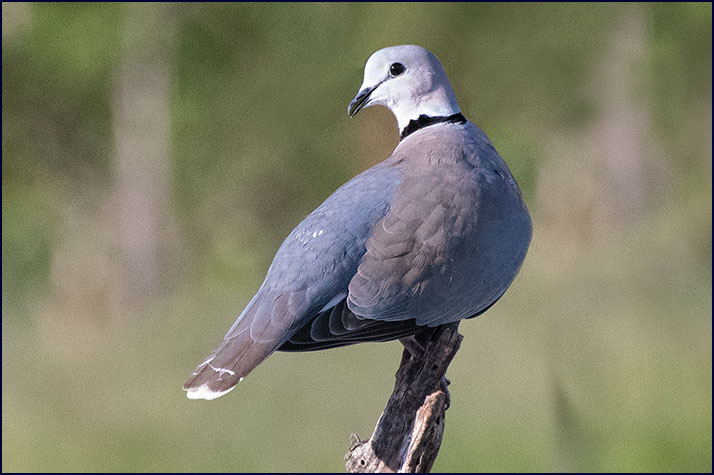
Cape Turtle
Dove |
As I was photographing the dove we were suddenly startled
by a loud trumpeting close by. While our attention had been on the
bird a whole herd of elephants had come up silently to the
waterhole on our left. They seemed to have snuck up on us; there
was not a sound until that sudden trumpet. A breeding herd of
about a dozen, they had three babies with them, and one of them
was tiny, only 2 weeks old Gee said. It still had pinkish ears.
The herd splashed skittishly
through the water, and then they left quickly; whenever there are
babies that young the elephants don’t want us to get too close.
We followed them a short ways at a distance to get a few more
glimpses of the baby.
A half dozen giraffes were near the road, standing close
together and intertwining their necks. Two of the boys were mock
fighting, wrestling with their necks and banging into each other
playfully. One of them crossed in front of us; he was magnificent
as he strode across the plain, almost glowing in the golden light
of evening.
Driving along a deep sand road, Gee had to brake suddenly
as a group of elephants burst out of the bushes and dashed across
the road right in front of us. Then a few minutes later yet
another group went rushing across; for some reason the elephants
seemed to be in a hurry this evening. There was a mother with a
tiny baby, not more than a couple weeks old. Mom was too far ahead
and the poor baby was running for all he was worth, his little
legs fully extended trying to keep up, but still lagging quite far
behind. This seemed unusual, as normally the mothers are very
protective and keep the small babies close; Gee said she might be
an inexperienced mother.
Three kudu bulls stood among the trees in the fading dusky
light – they looked like they belonged in an enchanted forest in
a fairy tale. They stared at us for a long moment, then turned and
silently disappeared beneath the dark trees.
|

Kudu bull at dusk
|
The camp crew cheered and whistled as we drove in; Mike let
out a piercing whistle in return. The stars were out tonight,
though without the brilliance of the dry winter season. Orion was
high in the sky, but upside-down, and Sirius shone straight
overhead. The guys called us to dinner by whooping like a hyena.
We noticed the little bicycle statue on the table was now accented
with feathers. Another excellent dinner. Sitting around the fire
having a glass of wine, we could hear elephants calling out and
breaking branches somewhere quite close to camp.
During the night we could hear the
lions roaring again – they sounded closer. We heard the faint
whooping call of hyenas passing by, and the noisy racket of
francolins along the dry riverbed.
February
10
The morning greeted us with the
faint, plaintive whistle of a pearl-spotted owl. Our wakeup call
came early; it was moving day. The camp staff had packed the
dining tent the evening before, and they were breaking down our
tents as we ate breakfast. We would be on an all-day game drive,
while the guys travelled to our new location in the Khwai
Concession Area and set up camp.
It was a clear morning with a
cloudless sky. We started out the day watching a huge herd of
impala grazing in the early light. We spent a little time with
some storks and hornbills. Mary said, ‘I
wonder what will happen next?’ This was becoming our
catchphrase.
Gee drove in the direction of where we had heard the lions
in the night and stopped to listen. After a while he heard them
call again, and he soon located them. There was a big male with a
lioness, and off to the side was another male. Gee said they were
from the Western Pride. Several jackals watched from a short
distance away; they were probably following the lions hoping to
get some scraps if they made a kill.
The
pair of lions continued sleeping, but the lone male got up and
walked toward us. He came right up to where we were parked,
crouched down beside the road not 50 feet from us, and had a long
drink from a large puddle. We watched as he lapped up the water;
he drank for almost five minutes.
After a while the lion stood up again and looked around.
Taking his time, he strolled right past the other two vehicles
that had arrived at the scene. Every few paces he stopped to look
around and scan the area. He walked across the roadway, pausing to
look both ways before he crossed.
He turned, and the morning sun
bathed his coat in gold. He gazed straight at us for a moment as
he passed, then stopped and looked back over his shoulder. His
tawny coat shone in the sun and the light reflected in his eye.
His long flowing mane, a mixture of blond, caramel and black,
looked fluffy like someone had brushed it. He wore an expression
of confidence and majesty. He looked lean and strong and every
inch the King of the Beasts.
The lion made a full circle before turning and heading back
toward the other members of the pride. He walked along the edge of
a small waterhole, mirrored by his reflection in the still water
beneath the clear blue sky. Amazing.
Gee always cut the motor when we stopped to watch the
animals – this time it took him a few tries to start the engine.
Though the mechanic had done some work on the starter it was still
a little reluctant. Gee turned the key repeatedly while the
starter made a clicking sound before it finally roared to life.
We saw a Long-crested Eagle, which
are very rare. A Burchell's starling shimmered blue in the
sunshine. As we passed the Savuti ranger’s camp we saw a herd of
impala snorting and making the alarm call – did they see wild
dogs? No, we quickly realized there was a ranger’s dog near the
camp and the impala were reacting to it.
Gee took us to see the Bushman’s Rock Paintings. He
parked by a tall cliff and led us up a short steep grade. Up on
the rock face we could see the 2000-year-old cave paintings; there
were some sable, an eland, a river and several elephants. With the
patches of bright sunshine and deep shade it was hard to make out
the images, but it was remarkable to think of the ageless history
depicted here.
|
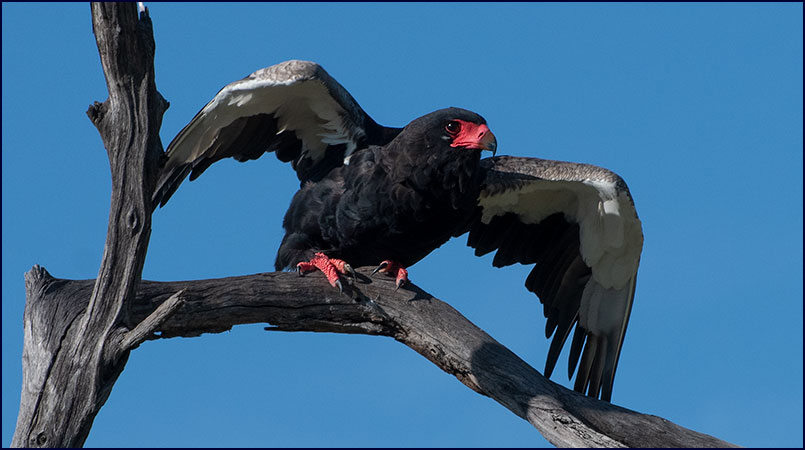
Bateleur |
As we drove back along the Savuti Channel we passed a
bateleur perched in a dead tree; we were able to get quite close
to where he sat basking in the sunshine. This handsome bird of prey
gazed down at us regally, the light shining in his eye (always
Gee’s requirement of a good bird photo). Then he raised his
wings and sailed off to loftier heights.
|